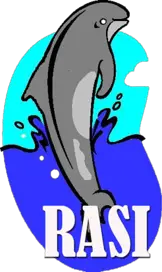Since Januari 1999 – August 2002 research has been conducted on the freshwater Irrawaddy Dolphin population (Orcaella brevirostris) locally known as the Pesut, by Danielle Kreb, and continued by bi-annual monitoring surveys (2005; 2007; 2010; 2012) in cooperation with Yayasan Konservasi RASI (YK-RASI) to collect data on trends in abundance, changes in distribution, habitat quality and threats to the pesut Mahakam.
(Pesut Mahakam fact sheets…547 Kb)
Based on the latest survey results in 2012, using Petersen mark-recapture analysis, the total dolphin population was estimated at 92 individuals.

The major threat involved direct mortality, which was largely caused by gillnet entanglement (66% of all deaths) with secondly boat collisions (10% of deaths). Mean annual mortality between 1995 and 2012was four dead dolphins per year. Other threats are habitat degradation through noise pollution from high-frequency generating boats passing core dolphin areas at high speed and the recent presence of oceanic coal-carrier ships that move upstream through major dolphin habitat raising considerable concern about the tremendous amount of underwater noise pollution these boats produce. The main other contributors to habitat degradation are chemical pollution mainly derived from coalmining waste cleaning and large-scale mono-cultivation plantations (especially oilpalm plantations with their man-made channels that function as outlet and prey depletion through unsustainable fishing techniques (electro-fishing, poison and trawl). Habitat displacement by dolphins from their main core areas has been noted caused by container barges transport in narrow tributaries causing loud underwater noise, sedimentation in lake habitat and conversion of fish spawning areas into palmoil plantations.
In time, changes in occupancy have occurred regarding previously identified core areas where the “Muara Pahu – Penyinggahan sub-districts area” represented the primary core area before 2007 in terms of densities as also observed by all generations of residents here, whereas the second largest core area was “the Pela/ Semayang – Muara Kaman area”. Currently, the first core area that was assigned as protected dolphin habitat reserve in 2009, has much lost of significance and dolphins are less and less often observed by local residents and also during four extensive surveys in 2010 and 2012, no dolphins were encountered here and neither in areas upstream of Muara Pahu, except for one isolated group that has made Ratah River as its habitat for 14 years now. The cause of habitat displacement is probably caused by the decreased habitat quality in the upstream areas and the subsequent decrease of fish resources in these areas due to opening of oilpalm plantations in fish spawing swamp areas that connect with this area as well as the intensity of electro-fishing and use of poison to fish in upstream areas.
Current conservation activities focus on gaining local governmental and community support to protect these areas through multi-stakeholder workshops and preparing a management plan with task division for each organization for each area. Mitigation of unsustainable fishing techniques by introducing more sustainable fishing techniques, restoring fish spawning areasand pollution reduction (due to chemical waste and boat noise) are vital components for the survival of this critically endangered freshwater dolphin population.
(Technical Report 2012….pdf 1,57 Mb)
DNA Mahakam & Malinau Irrawaddy Dolphin Analysis
Between 1999 and 2005, 6 samples from dead dolphins in the Mahakam and one sample from Malinau (northeast Kalimantan) were collected. All samples were sent to the lab of National Marine Fisheries Service/Southwest Fisheries Science Center (NMFS/SWFSC) La Jolla, USA and were sequenced (400 base region of the mitochondrial control region gene). The Indonesian samples sequenced and analyzed to date have yielded three different halpotypes. All six animals from the Mahakam have one of two different haplotypes. The dolphin from Malinau, has a different haploype than those animals found in the Mahakam. This Malinau haplotype matches a haplotype of several animals from the Songkla Lake area of Thailand and Philippines. When comparing the sequences of the animals from the Mahakam and Malinau, there are five fixed base pair differences. This indicates that animals from the two areas are evolutionarily different and that the Mahakam animals are, thus far, separate from other Asian Orcaella.

